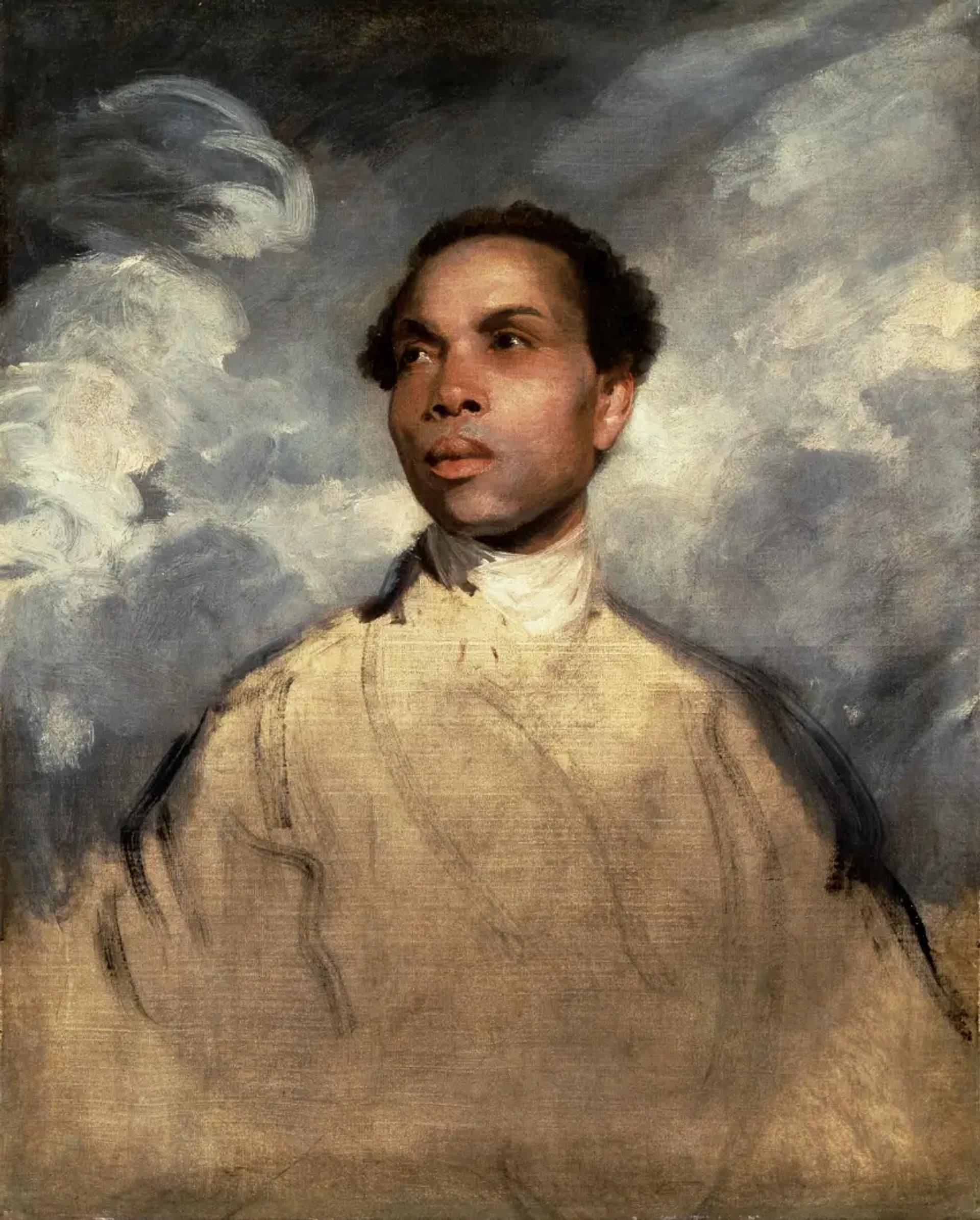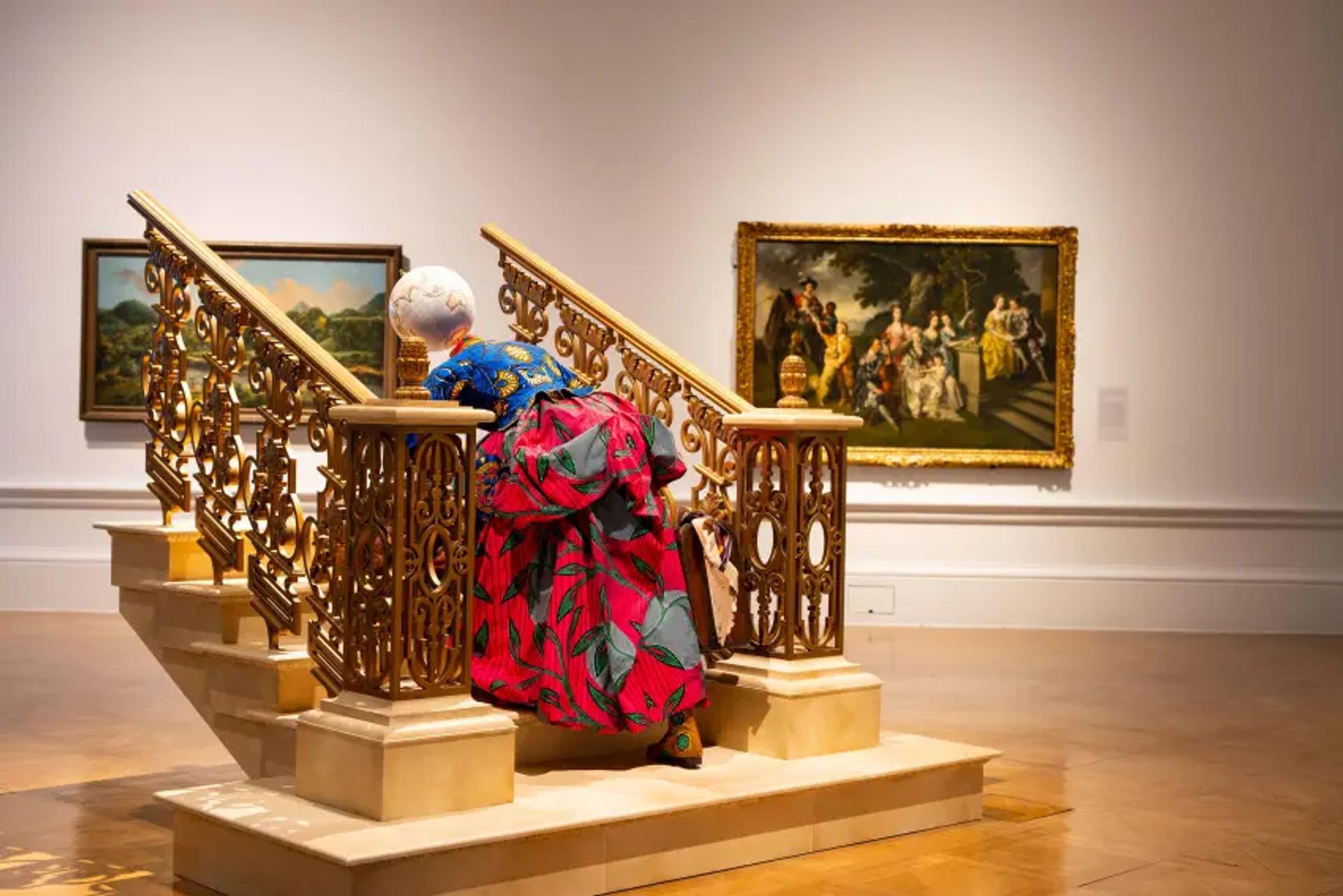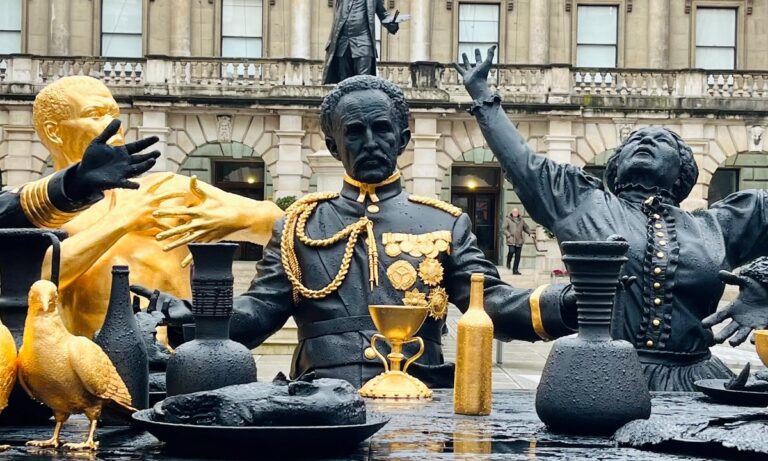I decided not to read any reviews of the Royal Academy programme, Entangled Pasts, 1769-Now: Art, Colonialism and Change (until April 28), before going to see her. I wanted to approach the exhibition with an open mind, and so on a rainy afternoon in February, I set out for Green Park not knowing what to expect.
In the courtyard, I was greeted by the monumental sculpture of Tavares Strachan, The First Supper (2023). It is in conversation or confrontation with the famous mural painting by Leonardo da Vinci, The Last Supper (around 1495-98). In Strachan’s sculpture, the heroes of Africa and the African diaspora dine at a sumptuously arranged table. Christ was replaced by Emperor Haile Selassie dressed in military uniform. I also recognized Marcus Garvey, Sojourner Truth and Shirley Chisholm.
The work is made of bronze and most of the piece is covered in a color that Strachan calls “galaxy black”. Some figures are adorned with gold, while others are completely covered in gold. The size of the work, the contrast between black and gold, and the dramatic poses of many of the figures, make the piece striking. Strachan’s work is not subtle, but as a black artist, presenting work in a space that has historically been unwelcoming to people of color, perhaps subtlety was not appropriate.
When I arrived, a small crowd was gathered around the sculpture. People took selfies and photographs but few came close. They were at a respectful distance, perhaps because of the play’s religious background. In the background, a statue of Joshua Reynolds stood on a plinth with his head turned from the scene below him. Reynolds’ gaze could avert with shock, horror, or guilt. Whether by accident or design, the Strachan figures are a similar shade of black to the Reynolds statue. Again, the two works seem to be in conversation or confrontation. I hurried in to see what else the exhibit had in store.
According to the audio guide, the exhibit was conceived after the murder of George Floyd in 2020, but didn’t open until February 2024. The long gestation period works in the exhibit’s favor. Tangled Pasts It seems more considerate than those initial knee-jerk responses to Floyd’s murder. Many responses were well-intentioned but, as time has shown, mostly ineffective.
So what is the show about? I would sum it up like this. The Royal Academy of Arts (RA) was founded in December 1768 by King George III. In 1768, the British Empire, the transatlantic slave trade, and white supremacist ideas were expanding. This context influenced the work produced by academics. Tangled Pasts explicitly addresses the RA’s role as an image maker for Empire, as well as bringing in contemporary artists of color, whose work interrogates European imperial systems and hierarchies.
What does all this mean? Well, let’s start with the opening room of the exhibition. There is a portrait of the famous black abolitionist Ignatius Sancho by Thomas Gainsborough. There is a portrait by Joshua Reynolds of a black man who may or may not be Francis Barber (Samuel Johnson’s heir). And then there is Kerry James Marshall’s imagined portrait of Scipio Moorehead, a slave artist who worked in Boston in the late 18th century. Gainsborough, Reynolds and Moorehead were all artists working in a similar time period, but only the works of the first two survive. Throughout the exhibition, contemporary artists of color, such as Marshall, represent the erased artists and voices of the past.

Joshua Reynolds, Portrait of a man, probably Francis Barber(around 1770) Photo © Hickey-Robertson, Houston
The juxtaposition works. It gives each room a tension that would be missing if the exhibit were organized purely chronologically. The works produced by academics of the past were mostly establishment art. There are many portraits of wealthy whites dressed in sumptuous clothing.
It’s nothing new, nothing I haven’t seen on the set of a period drama. But then place an 18th-century portrait of Prince George next to a 21st-century portrait of Kehinde Wiley, and suddenly there’s a frisson in the air. The postures of the main subjects are similar, with the chest out, the gaze strong, but one subject is black and the other white. Wiley is subverting the traditions of European portraiture, challenging who gets to be portrayed as noble and virtuous.
Is the exposure radical? yes and no Objectively, there is nothing radical about saying that British artists living in the age of empire produced works that erased the horrors of slavery and imperial expansion; it’s just stating the obvious. However, stating the obvious is something RA has not done for most of its existence, therefore Tangled Pasts is a radical exposure for AR.

Installation view showing Yinka Shonibare’s woman climbing (2023) Image: Courtesy of the artist and James Cohan Gallery, New York. Photo © Royal Academy of Arts, London / David Parry. © Yinka Shonibare CBE RA
At the end of the exhibition, the dialogue between past and present artists disappeared, and most of the works shown were contemporary. In quick succession, there were works by Frank Bowling, El Anatsui, Lubaina Himid and Yinka Shonibare. It almost started to look like a group concert.
Which led me to wonder why prominent artists like Yinka Shonibare are often only seen in group exhibitions in British institutions? Most of the contemporary artists appeared Tangled Pasts they have been working long enough to have retrospectives that look at their work in a deeper way. Maybe that’s the next step for AR.
As I left the show, I remembered the Igbo proverb, “Morning is when you wake up.” The RA seems to have woken up to its responsibility to present an honest view of its role in Britain’s imperial past. But as we’ve seen over the past four years, institutions that seemed to wake up can quickly go back to sleep. So to the commissioners of Tangled Past: well done and stay awake!

